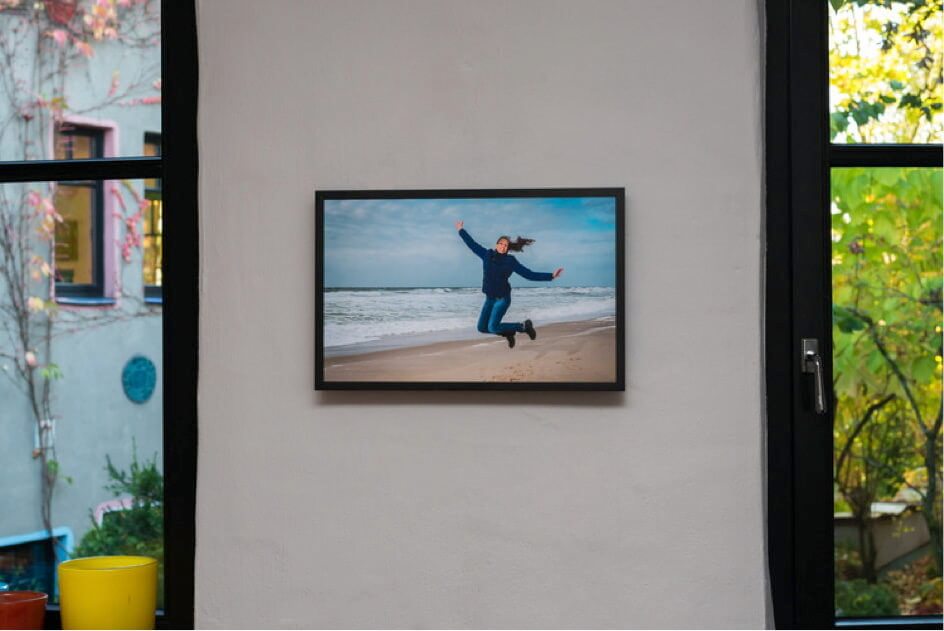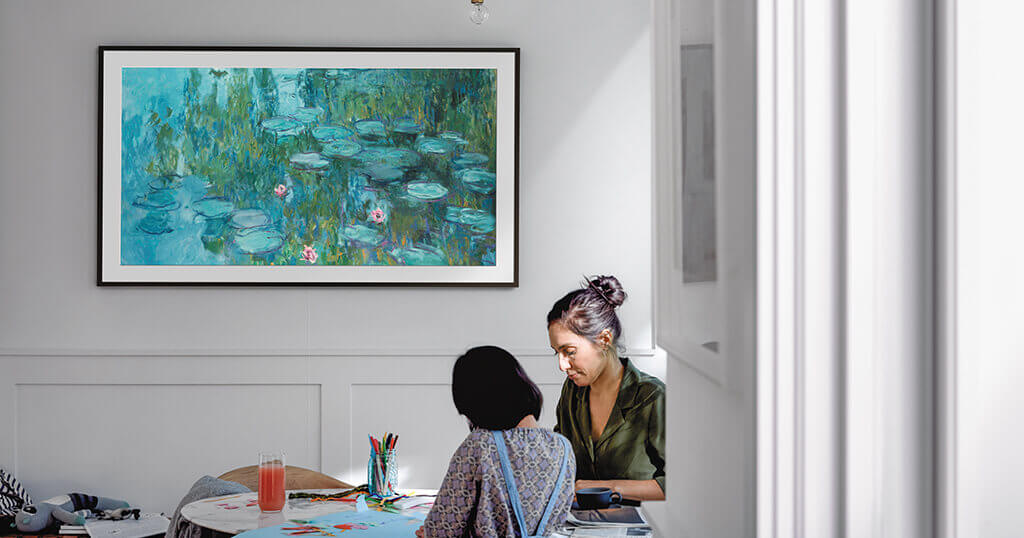If there is one thing that makes every digital picture frame on the wall look ugly, it’s a dangling power cord that runs from the frame to the power outlet.
You see those wonderful product images of Nixplay, Samsung, Netgear Meural, Framen, Canvia and Lenovo digital photo frames on the wall and rarely there is a cable in the picture. Now I am not saying that the cable was photoshopped out the image (although in some cases that may have happened), but I guess most images were taken in studio settings where it’s easy to hide the power cable nicely.
But what can you do at home to make your digital picture frame look nicely? I will share with you six tips on how to make your frame blend in with your furniture with no annoying power cord in sight.
One preliminary remark: All digital frames that I have seen have a wifi module and only require a power cable – except for Samsung’s The Frame, which has a proprietary cable that is connected to a TV controller unit. Samsung’s cable is also small, but the thing is that you have to hide this external box somewhere as well. I am not going to cover this issue in this article and will focus on hiding the power cable only.
So let’s dive right into it:
Use an existing wall light power connection
When I bought my first PhotoVu digital picture frame in 2005, we took a wall lamp down, which happened to be in a great spot. Instead of the lamp, we mounted the picture frame with the power cables just behind it.

Depending on the country and the type of apartment or house you live in, it can be quite common to have a number of existing AC outlets higher up on the wall to mount lights. Sometimes they may be hidden underneath a painted round plastic lid when they are not used.
They are typically connected to a light switch which may also control other lights. If that is the case, just make sure that this connection is severed and that the digital frame is not turned on/off with a hard switch. This may damage the unit over time and is not really useful if it also controls a light.
Make a groove in the wall
This sounds much more dramatic than it actually is. And if Trick #1 doesn’t apply, this is my recommended method.
If you live in a house built with bricks, it’s quite easy to make a groove in the wall where you can bury the cable. Just rent a wall groove cutting machine from your local DIY store, make sure to cover everything in the room because it may become a dusty affair, and put some earplugs in. If you can’t get your hands on a machine, just chisel away manually Berlin-wall 1989 style.
Ideally, you make a groove from the designated area for the picture frame to the nearest plug. Put in a high-quality cable with plenty of lengths on both ends. Fill up the groove with putty, let it dry and paint it over.

Connect it to the plug on the one end (CAUTION – FUSE!!) and add some luster terminals on the side where the frame will connect. If you have enough space, you can alternatively connect a power socket. That makes it easier to take the frame down if needed.

If you are using a rotating swivel mount like for the Netgear Meural, make sure that the cable is long enough to support the rotation.
The questions I often get when people see my DIY digital frame for the first time is “Where is the cable?” and “Is it battery powered?”. Never in a million years, would I want a cable running down from the frame.
It does look neat, doesn’t it?

Adding an extra surface
Have you ever wondered how ceiling lights are installed? It’s not that the builders make holes into the ceiling to mount the lights. Instead, they just add another layer, typically wood, and organize all the cables behind this layer before they put it up. You can do the same thing vertically.
No limits to your creativity. There are some great examples on Pinterest like these here:
Using cord hiders
I am a bit ambivalent regarding this one. In my opinion, cord hiders may be fine when you have a number of cables that you need to group together but since we only have one power cord on a digital picture frame, it makes the whole thing much larger and more visible.
But instead of using the normal rectangle cord hiders, you could get really creative and create something like this:
Using special cable types
Some manufacturers offer very flat cables that can be easily painted or even hidden underneath the wallpaper like Samsung’s The Frame model, but this can’t be used universally as it is the link to the TV controller box that comes with The Frame and not a normal power cable.
The Netgear Meural Canvas II comes with a very slim round power cord that looks quite nice but it is not invisible.
You can buy relatively flat cables like Koumeican but it is quite expensive. Cheaper alternatives are the ClearMax but it is not as flat.
Drilling through the wall
Depending on if your digital photo frame is mounted on an external or internal wall, and what the material of your walls is, it may be feasible just to drill a hole through the wall and have the power cable come out on the other side where you can hide it more easily.
Conclusion
Whichever method is an option in your house or apartment, it is worth a lot to think about how to hide best the power cable that comes from your picture frame.
Given the quality of the displays today, especially with frames like the Netgear Meural Canvas II, it is not easy at all to tell a screen from a real painting or printed photo at first look.
This degree of authenticity is amazing for you and your guests. But a visible power cable would give it all away.
So put in some effort to have your own digital picture frame as beautifully looking as in the brochures.
Have you found even better ways to hide your power cable? Please let me know!
Photos: Samsung (Feature Image), Wolfgang Männel
Was this article helpful?
Thank you for your support and motivation.
Related Articles
- How well does the Google Chromecast really work as a digital picture frame?
- My hands-on review of the Aeezo 9-inch WiFi Touchscreen Digital Photo Frame
- My review of Nixplay’s first WiFi touchscreen photo frame
- My review of the Dragon Touch Classic 10 Elite Digital Photo Frame with touch screen and WiFi
